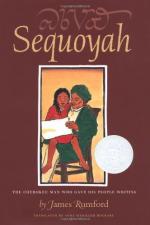|
This section contains 381 words (approx. 2 pages at 300 words per page) |
Encyclopedia of World Biography on Sequoyah
Sequoyah (ca. 1770-1843), Cherokee scholar, is the only known Native American to have formulated an alphabet for his tribe. This advance enabled thousands of Cherokee to become literate.
Sequoyah was born at the Cherokee village of Taskigi in Tennessee. His father probably was Nathaniel Gist, a trader. His mother was part Cherokee and was abandoned by her husband before the birth of Sequoyah. He used his Cherokee name until he approached manhood, when he assumed the name George Guess (as he understood his father's last name to be).
Crippled for life in a hunting accident, Sequoyah became an excellent silversmith. As an adult, he had contacts with whites which piqued his curiosity about "talking leaves," as he called books. In 1809 he determined to master this secret and to apply it to his own people. After a dozen years of ridicule and insults, he invented a Cherokee alphabet of 85 or 86 characters that allowed every sound in Cherokee to be written.
In 1821 Sequoyah demonstrated his invention before the Cherokee council, which approved his work. Within two years thousands of Cherokee had mastered the syllabary, an advance which stimulated the printing of books in the Cherokee language as well as some newspapers printed partly in Cherokee.
In 1823 Sequoyah went to Arkansas to teach his syllabary to the Cherokee who already had migrated westward, and he moved with them to Oklahoma in 1828. He became somewhat active in tribal politics and was a Cherokee delegate to Washington, D.C., in 1828. With his syllabary a success, Sequoyah devoted much of his time to studying other tribal languages in a search for common elements. His tribe recognized the importance of his contribution when, in 1841, it voted him an allowance, which became an annuity of $300.
Early in 1843 Sequoyah became interested in a tribal tradition that said that part of the Cherokee nation had migrated west of the Mississippi River prior to the American Revolution. He set out to find this group, a trek that led him westward and southward, and he died in August 1843, possibly in the state of Tamaulipas in Mexico.
Sequoyah is commemorated by the state of Oklahoma, which placed a statue of him in the nation's capital. Also, a redwood tree, the Sequoia, was named in his honor, as was the Sequoia National Park.
|
This section contains 381 words (approx. 2 pages at 300 words per page) |


